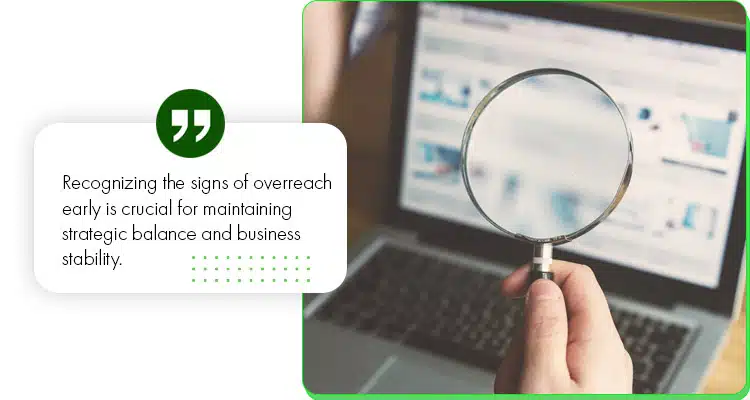Strategic overreach is a silent threat that can gradually erode the foundations of your business, much like a thief in the night. When companies stretch beyond their core strengths, the risks are subtle but severe: operational inefficiency, diluted brand identity, and resource strain.
Consider the story of a once-thriving retail brand that attempted to diversify too quickly into unrelated markets, only to face declining sales and a weakened brand. Or the tech giant that launched a series of ambitious projects, leading to project failures and a loss of market share.
These examples underscore the importance of recognising the dangers of strategic overreach. Understanding and avoiding these risks is essential for sustainable growth and maintaining a sharp focus on what your business does best. In this article, we’ll delve into the pitfalls of overreaching and offer strategies to help your organisation expand wisely without compromising its core competencies.
What is Strategic Overreach and Why Does It Matter?
Strategic overreach occurs when a business extends beyond its capabilities, resources, or expertise in pursuit of ambitious growth targets. It often stems from a desire to rapidly expand market share or diversify offerings without adequate planning or consideration of operational limitations. This can lead to a misalignment between strategic goals and the organisation’s ability to execute them effectively.
Common Examples of Strategic Overreach
- Rapid Expansion can be guided by a strategic template to ensure sustainable growth. Aggressively entering new markets or geographic regions without sufficient market research or local expertise can jeopardise your strategic initiatives.
- Product Line Overextension: Launching too many new products or services simultaneously, stretching resources thin and potentially diluting the brand.
- Acquisitions Beyond Core Competencies: Purchasing companies in unrelated industries without a clear integration strategy.
- Overambitious Growth Targets: Setting unrealistic revenue or market share goals that push the organisation beyond its operational capacity.
The Impact of Overreach on Business Strategy
Strategic overreach can have far-reaching consequences on a company’s overall business strategy and performance. It often leads to a disconnect between strategic planning and execution, resulting in suboptimal outcomes.
Example: TechGrowth Inc.’s Rapid Expansion
TechGrowth Inc., a mid-sized software company specialising in customer relationship management (CRM) solutions, decided to pursue an aggressive growth strategy. Their plan involved simultaneously expanding into three new market segments, launching a suite of new products, and entering five international markets within a two-year timeframe.
The Strategy
- Market Expansion: Enter healthcare, finance, and retail sectors with tailored CRM solutions.
- Product Development: Launch a new AI-powered analytics platform, mobile CRM app, and cloud-based enterprise solution.
- Geographic Expansion: Establish operations in the UK, Germany, Japan, Australia, and Brazil.
The Overreach
TechGrowth’s strategy, while ambitious, led to significant overreach:
- Resource Strain: The company’s financial and human resources were stretched thin across multiple initiatives. They lacked the expertise in new markets and struggled to hire and train staff quickly enough.
- Loss of Focus: By targeting multiple new markets and products simultaneously, TechGrowth lost focus on its core CRM business. This led to a decline in quality and customer satisfaction among existing clients.
- Operational Inefficiencies: The rapid expansion created complexities in operations, leading to inefficiencies in product development, marketing, and customer support across different regions and product lines.
- Financial Pressure: The costs of expansion, including new office setups, marketing campaigns, and product development, far exceeded initial projections, putting significant strain on the company’s finances.
- Cultural Challenges: Entering multiple international markets simultaneously led to difficulties in adapting to various business cultures and regulatory environments.
The Consequences
- Missed Targets: TechGrowth failed to meet its growth targets in new markets and product lines due to inadequate resources and lack of market understanding.
- Quality Issues: The rush to launch new products led to software bugs and compatibility issues, damaging the company’s reputation.
- Market Share Loss: While focusing on new ventures, TechGrowth lost market share in its core CRM market to more focused competitors.
- Financial Strain: The company’s profitability plummeted, and it faced cash flow issues, forcing it to seek additional funding at unfavourable terms.
- Employee Burnout: The pressure to deliver on multiple fronts led to high employee turnover and decreased morale.
- Strategic Confusion: Partners, customers, and employees became unclear about the company’s core focus and value proposition.
The Aftermath
After 18 months, TechGrowth was forced to reevaluate its strategy. They scaled back international expansion to focus on two key markets, discontinued two of the three new products, and refocused efforts on their core CRM business. The company had to undergo a significant restructuring, including layoffs and closure of several newly opened offices.
This example demonstrates how strategic overreach can lead to a disconnect between ambitious planning and practical execution capabilities. It highlights the importance of aligning strategy with available resources, core competencies, and market realities. TechGrowth’s experience underscores the need for phased, well-paced expansion and the importance of maintaining focus on core strengths while pursuing growth opportunities.
How to Identify Signs of Strategic Overreach?
Recognising the signs of overreach early is crucial for maintaining strategic balance and business stability. Here are some key indicators to watch for:
Key Indicators of Overreach in Your Business
- Declining Profit Margins: As the business stretches its resources, efficiency may suffer, leading to reduced profitability and necessitating a review of the privacy policy.
- Quality Control Issues can arise if the strategic framework does not adequately address operational behaviours.: Rapid growth or diversification can strain quality assurance processes, resulting in inconsistent product or service quality.
- Employee Burnout: Overambitious goals may lead to increased workload and stress on employees, potentially causing high turnover rates.
- Customer Dissatisfaction: Overextension can lead to a decline in customer service quality and responsiveness.
- Cash Flow Problems: Rapid expansion often requires significant capital investment, which can strain financial resources.
Assessing Your Strategic Decisions for Potential Overreach
To evaluate whether your strategic decisions may lead to overreach, consider the following contributing factors.
- Alignment with Core Competencies: Assess whether new initiatives leverage your existing strengths and expertise.
- Resource Availability: Evaluate if you have the necessary financial, human, and operational resources to support the strategy.
- Market Demand: Ensure there is sufficient market demand to justify expansion or new product launches.
- Competition Analysis: Analyse how your strategy positions you against competitors and whether it provides a sustainable competitive advantage through decisive actions.
What are the Consequences of Strategic Overreach?
Understanding the potential consequences of overreach is essential for making informed strategic decisions.
Operational Challenges and Reduced Productivity
Overreach often leads to operational inefficiencies as resources are stretched thin. This can result in:
- Decreased employee productivity due to increased workload and stress
- Inefficient allocation of resources across multiple initiatives
- Difficulty maintaining consistent quality standards
- Challenges in coordinating activities across expanded operations
Financial Implications of Overextending Your Strategy
The financial impact of strategic overreach can be significant:
- Increased capital expenditures without proportional revenue growth can be addressed by refining your executive strategy.
- Higher operational costs due to inefficiencies and redundancies
- Potential cash flow issues as resources are tied up in multiple initiatives
- Reduced return on investment (ROI) for new ventures or expansions
Impact on Stakeholder Trust and Engagement
Overreach can erode stakeholder confidence and engagement:
- Customers may experience declining service quality or product consistency
- Employees may feel overwhelmed and disconnected from the company’s vision
- Investors may lose confidence in management’s ability to execute strategies effectively
- Partners and suppliers may face challenges adapting to rapid changes or increased demands
What Strategies Can Help Mitigate the Risks of Overreach?
Implementing an effective strategy while avoiding overreach requires careful planning and execution within a well-defined framework.
Step 1: SWOT Analysis to Identify Gaps
A SWOT (Strengths, Weaknesses, Opportunities, Threats) analysis is a powerful tool for understanding your business model and identifying potential areas of overreach. By comprehensively examining internal and external factors, you can develop strategies to mitigate risks and capitalise on opportunities.
Strengths
Focus on leveraging core competencies and unique advantages within a strategic framework. Identify what sets your business apart from competitors and how these strengths can be utilised to drive growth and success. This may include proprietary technology, strong brand recognition, or exceptional talent within your organisation.
Weaknesses
Address internal limitations that may hinder strategy execution. Honestly assess areas where your business may fall short, such as outdated processes, skill gaps, or resource constraints. By recognising these weaknesses, you can develop targeted improvement plans and avoid overextending in areas where you lack expertise or capacity.
Opportunities
Prioritise opportunities that align with your strengths and market demand to maximise your contribution to the industry. Look for emerging trends, untapped markets, or potential partnerships that could propel your business forward. However, be cautious not to pursue every opportunity that arises, as this can lead to overreach.
Threats
Identify external factors that could exacerbate the risks of overreach. These may include changing regulations, new competitors, or economic downturns. By anticipating potential threats, you can develop contingency plans and ensure your strategy remains flexible in the face of challenges.
Step 2: Creating a Balanced Business Strategy Roadmap
Developing a roadmap that balances ambition with realistic capabilities is crucial for avoiding overreach. Begin by setting clear, achievable objectives that align with your core competencies. This ensures that your goals are grounded in your organisation’s strengths and expertise.
Next, prioritise initiatives based on their strategic importance and resource requirements. This step helps prevent spreading resources too thin across multiple projects. Establish realistic timelines for implementation and growth, allowing for proper planning and execution of each initiative.
Importantly, include contingency plans for potential challenges or market shifts in your strategic initiatives. This proactive approach enables your organisation to adapt quickly to changing circumstances without overextending its resources.
Step 3: Effective Execution Techniques that Avoid Overreach
To execute your strategy without overextending, consider the following techniques:
- Break down large initiatives into manageable phases. This approach allows for better control over resources and helps identify potential issues early in the process.
- Implement robust project management practices to track progress and resource allocation. Utilise tools and methodologies that provide real-time insights into project status and resource utilisation.
- Regularly review and adjust plans based on performance and market feedback. This iterative approach ensures that your strategy remains aligned with current market conditions and organisational capabilities.
- Foster cross-functional collaboration to optimise resource utilisation. By breaking down silos and encouraging teamwork across departments, you can leverage diverse skill sets and avoid duplicating efforts.
Step 4: Leveraging Agility and Adaptability in Strategy Implementation
Maintain flexibility in your approach:
- Embrace an agile mindset to respond quickly to changing market conditions
- Encourage innovation within defined strategic boundaries
- Develop scenario planning to prepare for various potential outcomes
- Cultivate a culture of continuous learning and improvement
Step 5: Integrating Continuous Improvement into Your Strategic Planning
Foster a culture of ongoing refinement:
- Regularly review and update your strategic plan
- Encourage feedback from all levels of the organisation
- Implement systems for capturing and acting on lessons learned
- Use key performance indicators (KPIs) to measure progress and identify areas for improvement in your strategic initiatives.
Step 6: Utilising Market Research for Informed Decision-Making
Base strategic decisions on solid market intelligence:
- Conduct thorough market research before entering new markets or launching new products
- Monitor industry trends and competitor activities
- Gather and analyse customer feedback to inform product development and service improvements
- Use data analytics to identify growth opportunities and potential risks
Step 7: Engaging Your Top Management Team in Strategy Development
Ensure alignment and buy-in from leadership:
- Involve key stakeholders in the strategy formulation process
- Encourage open dialogue and diverse perspectives to enhance the effectiveness of your strategic initiatives.
- Clearly communicate the strategic vision and objectives throughout the organisation
- Hold regular strategy review sessions with top management to assess progress and make necessary adjustments
Troubleshooting: How to Adjust Your Business Strategy When Overreach Occurs?
If signs of overreach begin to surface, such as declining efficiency, slipping product quality, or a loss of focus on your core business areas, it’s imperative to take corrective action immediately. Ignoring these early warning signs can lead to deeper operational and financial problems, making recovery more difficult and costly. Swiftly reassessing your strategic priorities, reallocating resources, and possibly scaling back on less critical initiatives can help your business regain its balance and focus. This proactive approach not only mitigates the immediate risks but also ensures that your organisation remains aligned with its long-term goals, safeguarding its stability and growth potential
Steps to Reassess and Adjust Your Strategic Objectives
- Conduct a comprehensive review of current strategies and their performance
- Identify areas where overreach is occurring and assess its impact
- Prioritise core activities and consider scaling back or divesting non-essential initiatives
- Realign resources to focus on key strengths and market opportunities
- Revise goals and timelines to reflect a more sustainable growth trajectory
Utilising Feedback to Navigate Back to a Good Strategy
Leverage input from various sources:
- Analyse customer feedback to understand the impact of overreach on satisfaction and loyalty
- Gather insights from employees on operational challenges and potential solutions
- Consult with industry experts or advisors for external perspectives
- Use market data to validate strategic assumptions and inform adjustments
Empowering Teams to Conduct Responsive Adjustments
Foster a culture of adaptability:
- Delegate authority to make tactical adjustments within strategic guidelines
- Encourage cross-functional problem-solving to address challenges
- Provide training and resources to help teams navigate change effectively
- Recognise and reward initiatives that successfully address overreach issues
In conclusion, while ambitious growth is often desirable, strategic overreach can significantly hurt your business by compromising operational efficiency, financial stability, and stakeholder trust. By understanding the risks, implementing balanced strategies, and remaining vigilant for signs of overextension, businesses can pursue growth opportunities while maintaining a strong foundation for long-term success. Regular assessment, adaptability, and a focus on core competencies are key to avoiding the pitfalls of strategic overreach and ensuring sustainable business performance.
Want more references that can help you grow your business faster?— Check these out!
- Want FREE AI Prompts for Different Areas of Your Business? Check out these 100 AI prompts.
- Ready to Build a FULLY Remote Team with the Right People? Click here.
- Check Out Our 1,000 Fully Vetted and Highly Talented Staff here.























